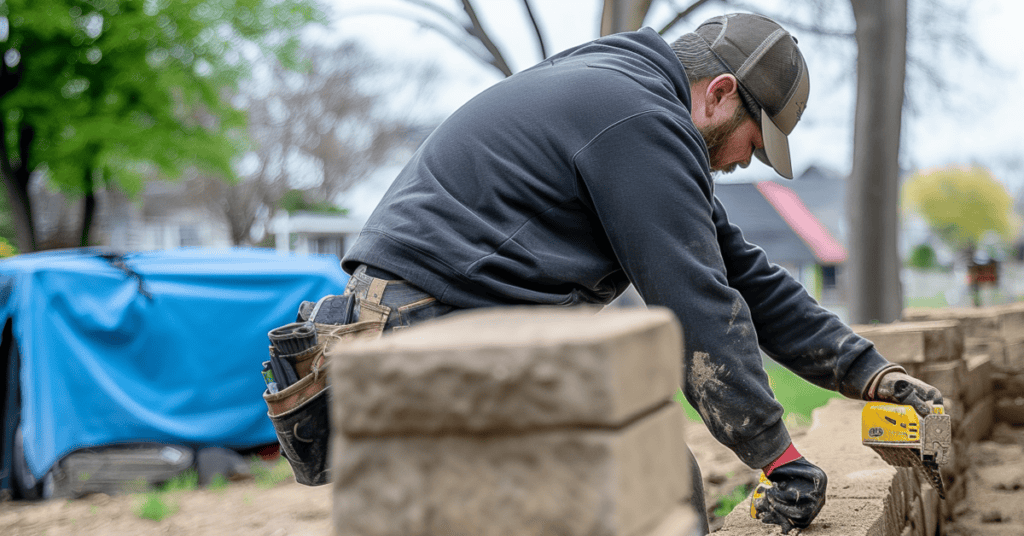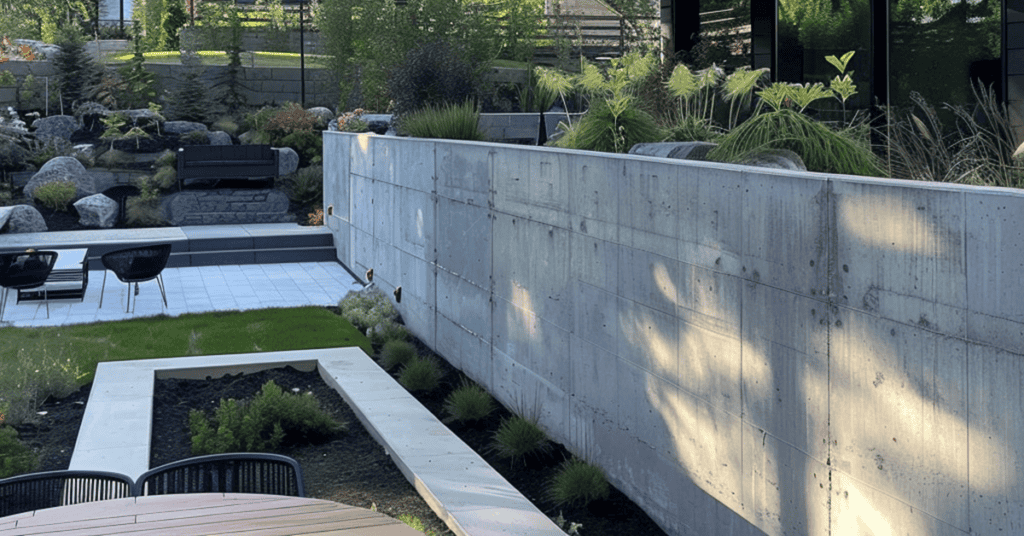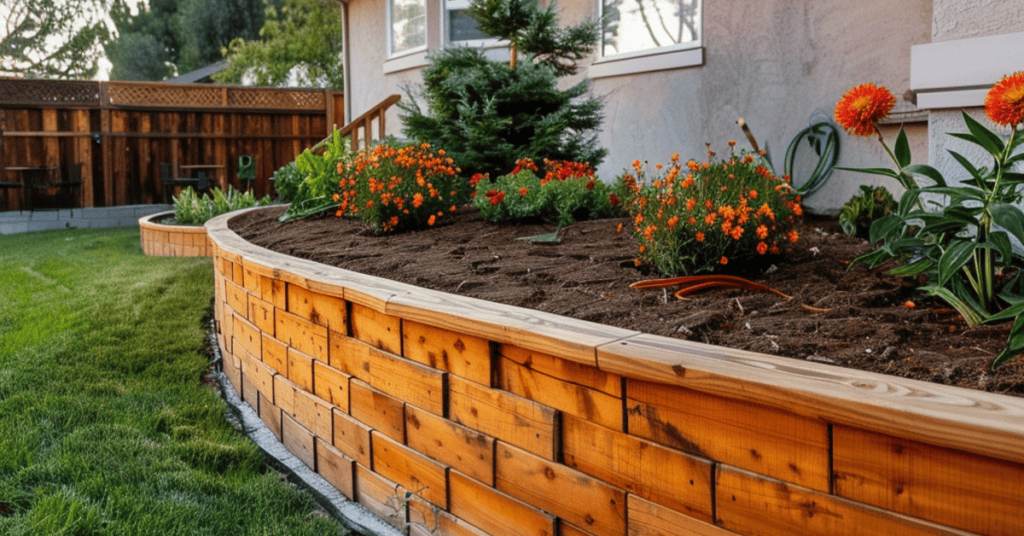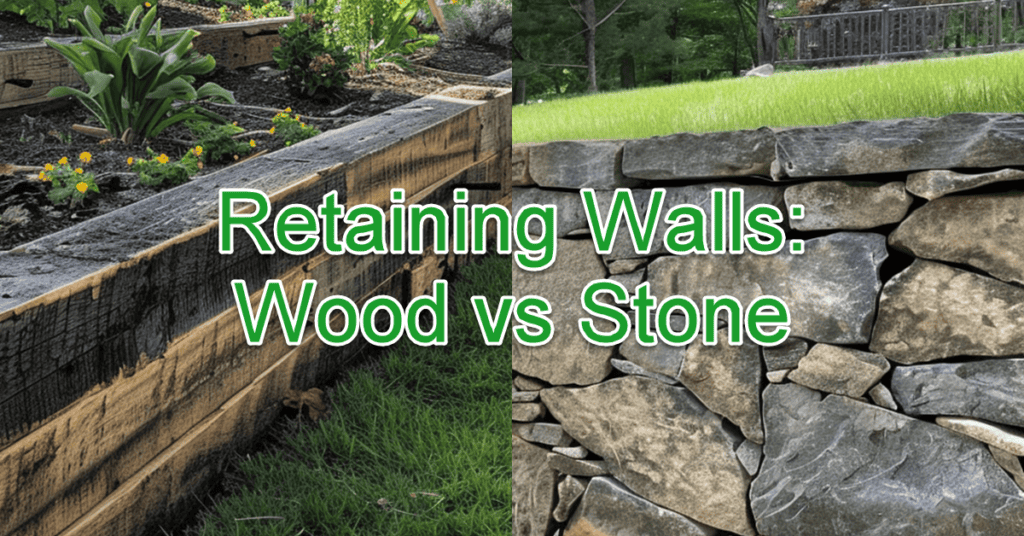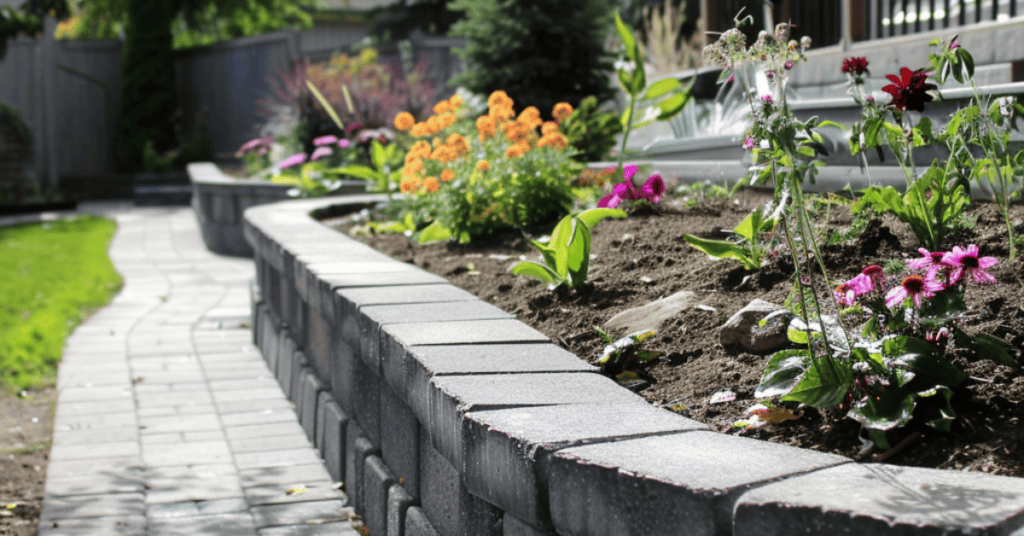Different Types of Retaining Walls for Your Yard
Retaining walls are not only an aesthetic component of landscape design, they’re also pivotal in controlling soil erosion and managing steep slopes on your property. You can also install an aesthetically pleasing garden bed or planting area on top of your retaining wall in many cases (especially if it is installed on a slope). A retaining wall also provides you with more usable space in your yard. All of these factors combined makes getting started on a retaining wall project a no-brainer for many Denver Metro area homeowners.
Design Principles for Retaining Walls
When designing retaining walls, it is vital to consider how they integrate with the landscape, the appropriate color and texture, and structural needs.
Landscape Integration
A well-designed retaining wall should blend with the existing landscape. This involves understanding the natural contours and selecting materials that complement the surroundings. For example, using natural stone can create a cohesive look in a garden setting. Retaining walls can also be used to create terraces or steps, adding depth and function.
Placement is another key element. Walls should be positioned to enhance the space, such as framing a garden or creating a seating area. Incorporating plants into the design can soften the hardscape and make the wall blend seamlessly into the background.
Color and Texture Selection
When it comes to retaining wall design, color and texture are important in making a visually appealing wall. Neutral tones like gray, beige, and brown often work well as they match most landscape designs. Bold colors can make a statement but should be used sparingly to avoid overpowering the space.
Texture adds another dimension to the design. Rough textures like those of natural stone or brick can give a rustic feel, while smooth finishes like polished concrete offer a modern look. Mixing textures can also create interesting contrasts and add visual interest to the wall.
Structural Considerations
The structural integrity of a retaining wall is crucial. Materials like concrete blocks, bricks, and treated timbers provide strong support. Each material offers different benefits and should be chosen based on the specific needs of the site. For instance, concrete blocks are durable and versatile, allowing for various design possibilities.
Retaining Wall Material Options
Different materials can be used to build retaining walls, each offering a unique look and set of benefits. Common options include natural stones like granite and limestone, manufactured bricks and concrete solutions, wood varieties, and alternative materials such as Corten steel and recycled options.
Natural Stone Choices
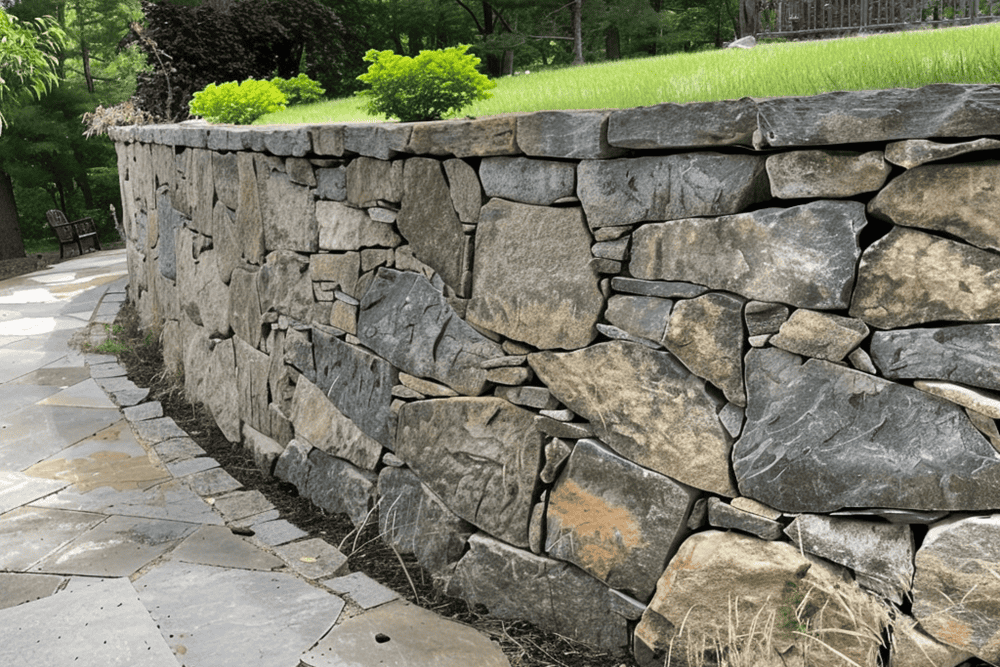
Natural Stone Retaining Wall
Natural stones offer a timeless and elegant look. Common choices include granite, limestone, and sandstone. Stone wall materials are durable and can withstand harsh weather conditions.
Using large boulders or river rock can give a more rustic appearance. Natural stones also provide excellent drainage, which is crucial for retaining walls. While a boulder retaining wall can be beautiful, material costs – as well as the labor cost involved in working with boulders can add to your overall cost.
However, these materials required for building a stone retaining wall can be pricey and difficult to work with. This can in turn result in a more expensive installation. Despite the cost, the aesthetic and longevity can make natural stone a worthwhile investment for many homeowners.
Brick and Concrete Solutions
Bricks and concrete are versatile and affordable options.
A concrete block retaining wall offers a nice blend of durability and cost. Concrete blocks and cinder blocks are often used due to their strength and ease of installation. These materials can be stacked and reinforced with steel rods for added durability.
Interlocking concrete blocks are another option. In fact, If you’re interested in putting together a DIY concrete retaining wall, you can get the materials you need from your local home improvement store (like Lowe’s or Home Depot). Larger stores allow you to purchase retaining wall blocks by the piece or by the pallet.
A brick retaining wall can be arranged in various patterns like herringbone or stretcher bond. For a more finished appearance, a stone veneer can be added to concrete walls. This will give the wall the look of natural stone without the higher cost.
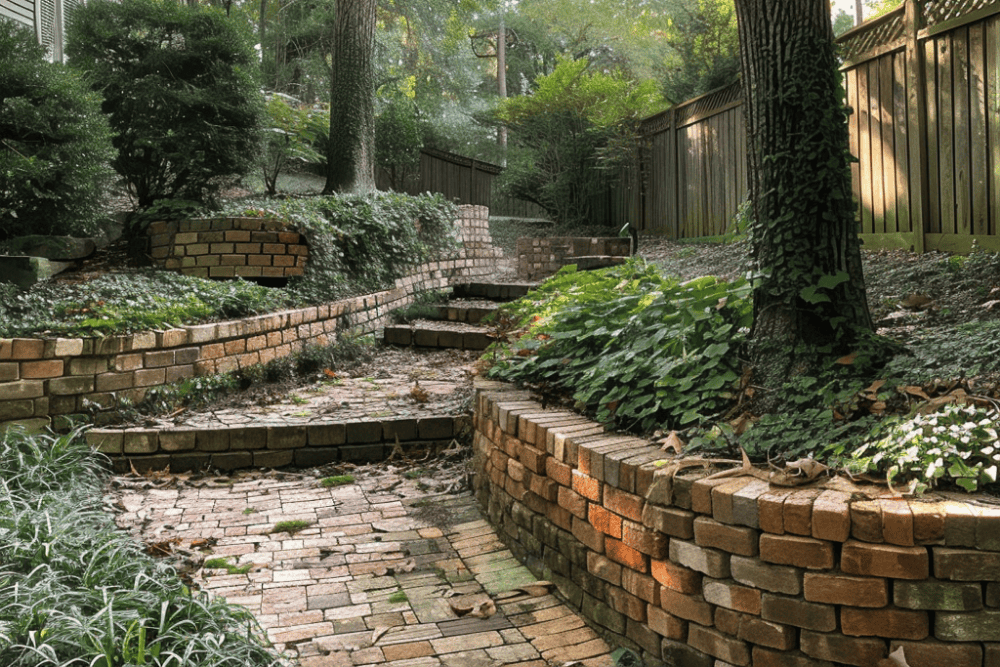
Brick Retaining Wall Next to a Walkway in a Residential Backyard
Wood and Timber Varieties
A wooden retaining wall provides a natural, rustic look. Materials such as treated timbers and railroad ties are commonly used. These wood types are treated to resist rot and insects, making them durable for outdoor use. You can even have a wooden curved retaining wall constructed of wood that perfectly matches the contour of your planting areas.
A timber retaining wall blends well with garden landscapes and is more affordable upfront. However, they require regular maintenance to prevent decay and may need to be replaced sooner than stone or concrete alternatives.

Wood Retaining Wall in a Denver Backyard
If you’re looking for a small retaining wall (or a low retaining wall) – wood is a good choice. For building taller retaining walls – or walls that will be under a lot of pressure, you’re better off using materials like concrete or stone.
Wood Retaining Wall ideas
Alternative Materials
Alternative materials like Corten steel and recycled plastic offer unique and eco-friendly options. Corten steel develops a rusted look over time, which can add a rugged aesthetic to the landscape. It is durable and low maintenance.
Recycled plastic and other eco-friendly materials provide sustainable options for retaining walls. While these may not offer the same natural look as stone or wood, they are resistant to weather and decay, making them long-lasting choices.
Using these alternative materials can also contribute to a sustainable building approach, reducing the use of non-renewable resources.
Types of Retaining Walls
Retaining walls can be constructed in various ways, each suited for specific needs and landscape requirements. They vary in materials like stone, wood, boulders, and concrete, and include different structural designs to hold back soil effectively.
Gravity and Stacked Stone Walls
Gravity walls rely on their mass to resist pressure from the soil. These are often built using heavy materials like concrete, stone, or large boulders. Stacked stone walls are a popular type of gravity wall. They require no mortar and use the weight of carefully placed stones to remain stable. 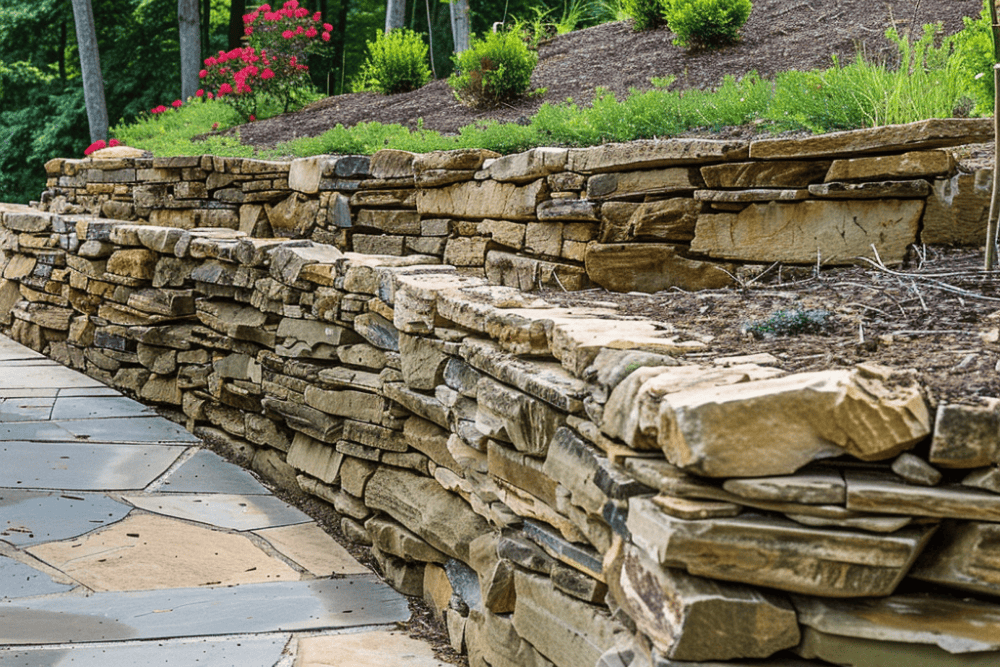
Stacked Stone Retaining Wall
- Advantages:
- Natural aesthetic
- Durability of materials like stone
- Considerations:
- Requires skilled labor for construction
- Limited to shorter walls due to stability concerns
Cantilever and Reinforced Walls
A cantilever retaining wall has two parts: a horizontal slab and a vertical stem. The base slab uses leverage to support the wall, making them efficient for larger loads. Cantilever walls are often constructed using poured concrete or masonry that is reinforced with steel.
- Advantages:
- Can support greater loads and heights
- Economical for medium to tall walls
- Considerations:
- Requires precise engineering and construction
- More expensive than simpler designs like gravity walls
Anchored Walls
Anchored walls use cables or stays anchored into the rock or soil behind the wall, providing extra support. This makes them suitable for high walls or when space is limited.Advantages:
Gabion Walls
Gabion walls consist of wire mesh filled with rock or concrete debris. They are flexible and can adapt to soil movement. This same flexibility may result in periodic maintenance of the wall. A gabion wall is also unsightly to some as the mesh structure that helps to keep the wall in place can be unsightly.
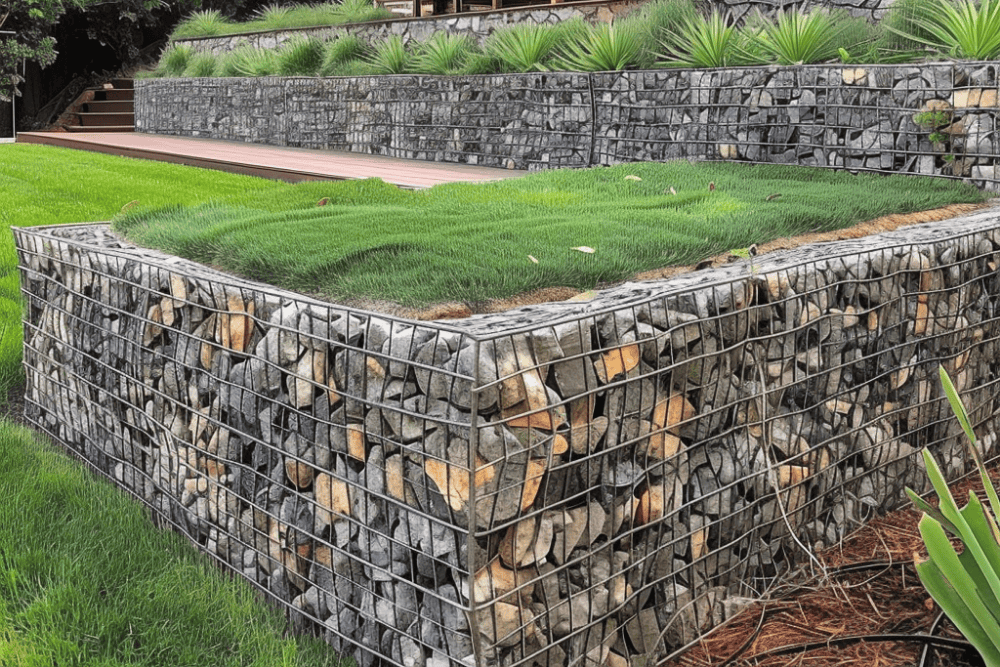
Gabion Retaining Walls are Wire Mesh Baskets Filled with a Filling Material (Usually Stone)
Retaining Wall Decorative Features
Enhancing a retaining wall with decorative elements can transform an outdoor space, making it more functional and attractive. Features like seating, lighting, water additions, and fire pits can add to the ambiance and usability.
Seating and Social Areas
Incorporating seating into a retaining wall can create comfortable social areas. Wood or stone benches built into the wall offer a seamless look. Cushions and pillows can add extra comfort. These seated areas can provide a place for relaxation and conversation.
Using materials like recycled wood, granite, or concrete can match the theme of the garden or yard. Whether near a fire pit or overlooking a garden, integrated seating is both practical and stylish.
Lighting and Ambiance
Lighting can enhance the look and safety of retaining walls at night. LED strips or recessed lights can be placed along the top or bottom of the wall for subtle illumination. Solar-powered lights are also a great eco-friendly option that can reduce energy costs.
Uplighting can highlight the textures and materials of the wall, creating striking shadows and visual interest. Proper lighting not only helps with visibility but also enhances the overall mood of the outdoor space.
Water Features and Fire Pits
Adding water features or fire pits to a retaining wall can create focal points in the outdoor space. Waterfalls or small fountains built into the wall can provide soothing sounds and cool breezes. They can be made from various materials, such as stone or metal, to match the design.
Fire pits can be integrated into the wall for cozy gatherings or outdoor cooking. They provide warmth and become natural gathering spots. Both water and fire features can transform a simple retaining wall into a multifunctional entertainment area.
Incorporating Greenery
Adding greenery to retaining walls enhances the natural beauty of a landscape and contributes to environmental benefits. Choices range from plants that thrive on walls to creative garden setups and vertical gardens.
Plant Selection for Retaining Walls
Choosing plants suitable for retaining walls is crucial. Succulents are excellent because they need little water and are resilient. Fern and ivy are other great options; their spreading nature helps cover large areas, creating a lush look.
Small trees and bushes can also be anchored at the top of a retaining wall. These not only add height but also provide shade. Flowering plants like marigolds or petunias add a pop of color against the wall’s surface. It’s important to consider the wall’s sun exposure and choose plants accordingly.
Creating Gardens and Flower Beds
Retaining walls can transform into garden and flower bed spaces, enhancing property aesthetics and functionality. Terraced garden beds work well for growing vegetables, herbs, and flowers. Each level can be dedicated to different types of plants, maximizing the use of space.
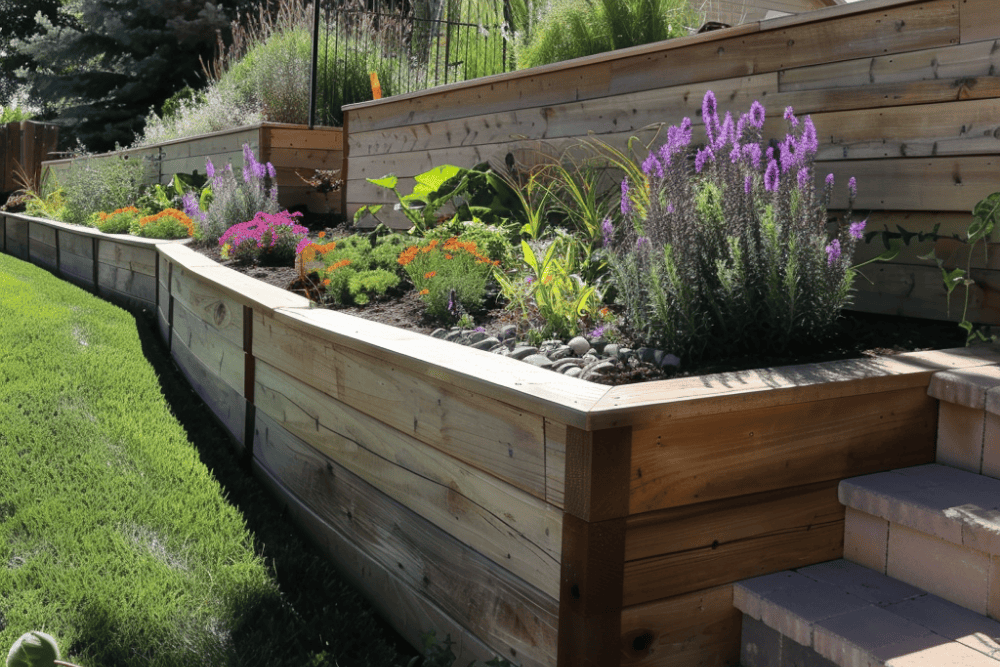
A Retaining Wall with a Planting Area on top of the Wall
Using a retaining wall to create a raised flower bed allows for better water management and less soil erosion. This setup also makes the garden area easier to maintain. Retaining walls near a lawn can integrate smoothly with the grass, creating distinct and organized plant zones.
Vertical Gardens and Green Walls
Vertical gardens and green walls are innovative ways to incorporate greenery into retaining walls. They use specially designed containers that hold soil and plants against the wall. These gardens can include a variety of plants such as herbs, succulents, and small flowers.
Installing a green wall can also help in urban areas where space is limited. This approach not only beautifies but can improve air quality and provide insulation to the wall. Incorporating a pond near the base of these walls can add an extra dimension of tranquility and help support a micro-ecosystem.
Functional Landscaping Elements
Retaining walls can be more than just structural supports; they can enhance the visual appeal of your garden, patio, or driveway, while also serving functional purposes.
Garden and Patio Connection
A garden retaining wall can create a seamless connection between garden spaces and patios. By using materials like stone or wood, the wall becomes both a boundary and a design element. For example, surrounding a vegetable garden with a low wall can provide better soil control and improved drainage.
These walls can also be used to create raised flower beds, which provide visual interest and ease of maintenance. The raised beds can be planted with colorful flowers or herbs, adding both beauty and utility to the garden.
In a patio setting, retaining walls can double as seating areas. This is not only practical but also maximizes space, making it more inviting for gatherings.
Driveways and Walkways
Retaining walls can significantly enhance the structure and appearance of driveways and walkways. For instance, they can be used to frame the driveway, giving it a more polished and defined look.
Materials like bricks, concrete blocks, or natural stones are often used, each adding a unique touch to the landscaping design. A well-designed retaining wall can help prevent soil erosion along the driveway, maintaining a clean and safe path.
Walkways can benefit from retaining walls too. Installing walls along walkways can guide traffic flow and create garden pockets for planting decorative shrubs or flowers. These elements enhance curb appeal and provide a welcoming entry to the home.
Terraces and Elevated Features
Among the most popular retaining wall design ideas, Terraced flower beds are a great way to handle sloped yards. You can create a tiered retaining wall system to transform a hilly area into multiple usable garden spaces. Each level can be a distinct planting zone, featuring different plants or themes.
Elevated features like decks and gazebos often require structural support from retaining walls. These walls ensure stability and blend the elevated elements with the surrounding landscape. Using uniform materials for terraces and elevated features creates a cohesive look.
These terraces can also enhance the aesthetic value of a landscape by creating visual layers. This not only makes the space more interesting but also increases the functionality by adding more planting areas.
her elements. Applying a sealant every couple of years can make a significant difference.
Need a retaining wall Contractor?
Contact us – or view our directory of Denver metro retaining wall contractors for more information.

